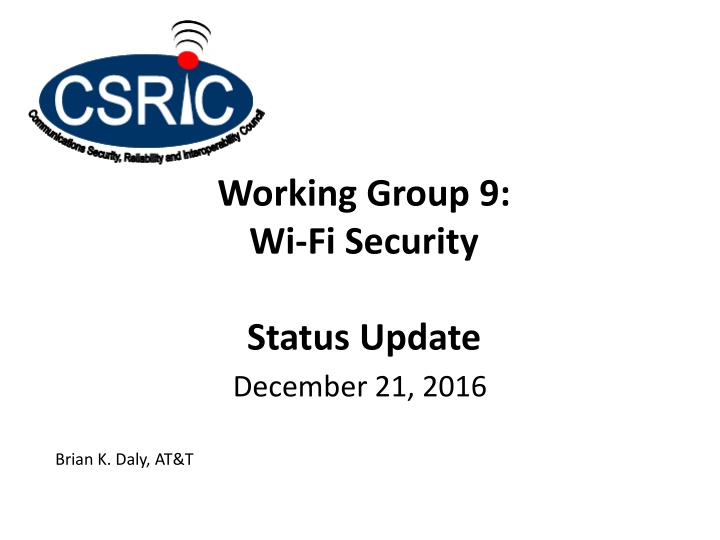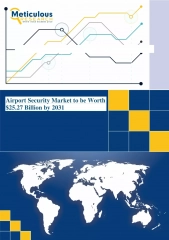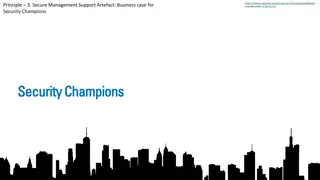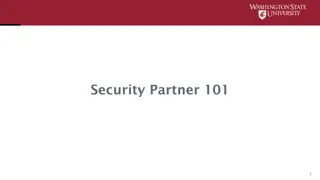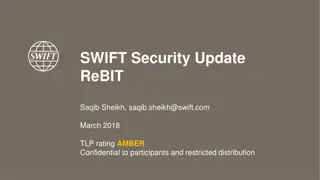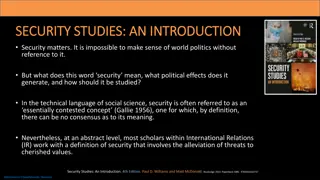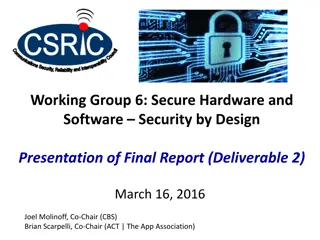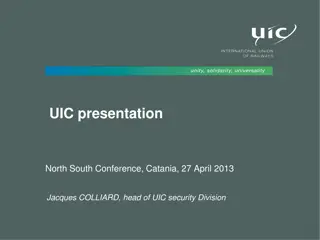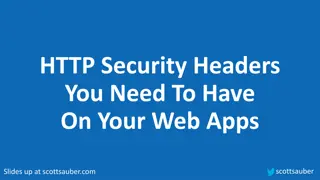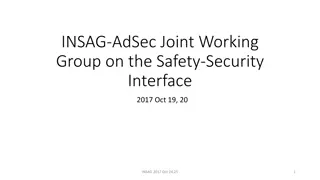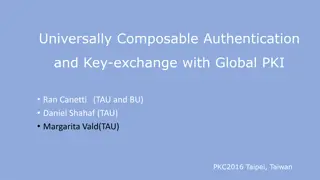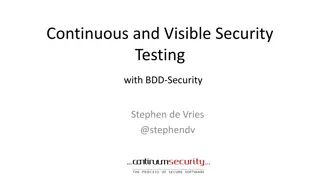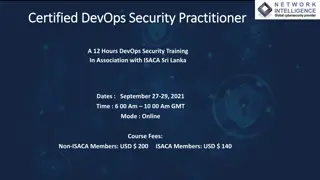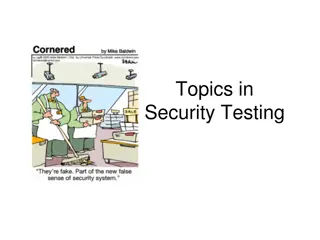Wi-Fi Security Update - Working Group 9
Providing an update on Wi-Fi security status, Working Group 9 aims to develop best practices for enhancing security in Wi-Fi networks and devices. The group will address threats, security techniques, and deliver recommended practices by March 2017. Membership includes industry experts and FCC liaisons collaborating on the deliverable progress.
Download Presentation

Please find below an Image/Link to download the presentation.
The content on the website is provided AS IS for your information and personal use only. It may not be sold, licensed, or shared on other websites without obtaining consent from the author.If you encounter any issues during the download, it is possible that the publisher has removed the file from their server.
You are allowed to download the files provided on this website for personal or commercial use, subject to the condition that they are used lawfully. All files are the property of their respective owners.
The content on the website is provided AS IS for your information and personal use only. It may not be sold, licensed, or shared on other websites without obtaining consent from the author.
E N D
Presentation Transcript
Working Group 9: Wi-Fi Security Status Update December 21, 2016 Brian K. Daly, AT&T
TOPICS Brief WG9 Background Including Objectives, Deliverables, Membership Status update Next Steps 2
WG9 Objectives & Deliverable Working Group Description: WG9 will develop, for CSRIC s consideration, recommended best practices for promoting security in networks and devices utilizing Wi-Fi spectrum bands. Security concerns threaten entities utilizing Wi-Fi devices and spectrum. Currently, enterprises utilizing Wi-Fi spectrum rely on numerous methods to secure their networks and connected devices from malicious attacks. Working Group 9 will identify, for CSRIC s consideration when, and under what circumstances, the use of a variety of advanced security techniques are appropriate. Specifically the Working Group will identify, for CSRIC s consideration: 1. The threats most consistently facing Wi-Fi network operators and users; 2. The available security techniques to prevent and/or remediate the threats; 3. The extent to which each technique is effective against specific threats, avoids interference with legitimate activity, is easily deployed, and is currently deployed. Working Group Deliverable: Prepare and present recommended security best practices for Wi-Fi operators, users, and consumers. March 2017 3
WG9 Membership NAME Paul Hancock COMPANY/AFFILIATION AT&T Services, Inc. WG9 Chair: Brian K. Daly, AT&T Robert Mayer USTelecom Association Phil Levis Stanford Jon Green Aruba Mohammad Khaled Nokia FCC Liaisons: Peter Shroyer Kurian Jacob Stephen Orr Cisco Bing Yang Uconn Miles Green Intersection (LinkNYC) David Savage Boeing Pat Walsh Gogo Inflight WG Editor DeWayne Sennett, AT&T Joe McManus CU Boulder Craig Cowden Charter Communications Jesse Walker Intel Jose Jiminez Cox Brian Scarpelli ACT Scott Craighead IAEE Sameer Khan Sprint Mark S. Sims Javits Convention Center Mark Haley Smart City Brad Mayne International Association of Venue Management 4
WG9 Status Work in progress on the deliverable Working on baseline document Version0.10 is the latest Contributions and discussions Biweekly calls Email discussions 5
WG9 Draft Deliverable Outline 1 Results in Brief 1.1 Executive Summary Introduction 2.1 CSRIC Structure 2.2 Working Group 9 Team Members Objective, Scope, and Methodology 3.1 Objective 3.2 Scope 3.3 Methodology Current Security Weaknesses in Wi-Fi 4.1 Wi-Fi Threats Discussion Paper 4.1.1 Background and Context 4.1.2 Wi-Fi Threats 4.1.3 Discussion Definition of Potential Wi-Fi Security Threats 6 Use Cases & Threats Most Consistently Facing Wi-Fi Network Operators and Users 2 6.1 6.2 6.3 6.4 6.5 6.6 6.7 6.8 6.9 6.9.1 Connected Home IoT Devices Use Case 6.9.2 Wearable IoT Devices Use Case 6.9.3 Connected Medical IoT Devices Use Case In-Home Wi-Fi Network Use Case In-Vehicle Wi-Fi Network Use Case In-Flight Wi-Fi Network Use Case Public Municipal Wi-Fi Network Use Case Commercial Subscription/Fee-Based Wi-Fi Network Use Case Hotel Wi-Fi Network Use Case Convention Center/Public Venue Wi-Fi Network Use Case Private Enterprise Network Use Case Use Cases for Connected IoT Devices 3 4 5 6
WG9 Draft Deliverable Outline 7 8 Summary of Threats Most Consistently Facing Wi-Fi Network Operators and Users Security Technique Effectiveness, Interference, Ease of Deployment, & Deployment Status End User Experience with Wi-Fi Security Conclusions Recommended Security Best Practices for Wi-Fi Operators, Users, and Consumers 9 10 11 Appendix A: Summary of CSRIC WG2A Cyber Security Best Practices Report Appendix B: Summary of NIST Establishing Wireless Robust Security Networks Report Appendix C: Suggested Background Reading Appendix D: Acronyms Appendix E: References Revision History 7
WG9 Initial Discussions Current Security Weaknesses in Wi-Fi A Comprehensive Review of 802.11 Wireless LAN Security and the Cisco Wireless Security Suite Wireless LAN deployments should be made as secure as possible 802.11 Authentication and Its Weaknesses WEP Encryption and Its Weaknesses Secure 802.11 Wireless LANs with Cisco Wireless Security Suite Cisco LEAP Architecture (user-based mutual authentication) 8
WG9 Initial Discussions WG is looking at defining Use Cases & potential Wi-Fi Security Threats: Use Cases: 1. Grouping #1 a. In-Home Use Case 2. Grouping #2 a. Commercial Subscription Use Case b. Hotel Use Case c. Private Enterprise Use Case 3. Group #3 Convention Center & Large Venue a. Convention Center/Public Venue b. Public Municipal Use Case 4. Group #4 a. IoT Use Cases i. Connected Home Use Case ii. Wearable IoT Devices Use Case iii. Connected Medical Devices Use Case b. In- vehicle Use Case c. In-flight Use Case Potential Threats: Ad Hocs and Soft APs AP Security including software Data Interception Denial of Service Endpoint Attacks Evil Twin Hack into Other Systems via Wi-Fi Malware Distribution Man in the Middle Misbehaving Clients Misconfigured APs Multiple Domain Issue Misuse of Wi-Fi networks for threatening or intimidation reasons Privacy Rogue APs Wireless Intruders Wireless Phishing 9
WG9 Wi-Fi Threats Discussion Attacks and compromises of cyber-systems work by attackers invoking unanticipated or unintended system behavior, not via some magical or supernatural powers Example: Wi-Fi specifications call for a Wi-Fi device to send messages to another by broadcasting over a radio channel, with the goal of emulating a point-to-point link between the two However, any other radio receiver listening on the same broadcast channel can receive the message behavior that is not intended by the Wi-Fi specification An easy attack against unsecured Wi-Fi is to utilize this unintended behavior to eavesdrop on messages exchanged among devices Security is a global property, because one vulnerability anywhere in the system can lead to a compromise of the entire system Security must be traded off against all the other emergent global system properties performance, cost, energy consumption, usability, etc. System architecture provides the roadmap for attacks on the system 10
WG9 Wi-Fi Threats Discussion The first job for any cyber-security project: Select adversary models appropriate to its needs, as this is the only way we know to identify what security problem needs to be solved Security goal then is to deter or otherwise mitigate an adversary with the assumed skills, so that it is no longer possible (or at least expensive) to uses these skills to expose unanticipated system behavior 11
WG9 Wi-Fi Threats Discussion Compared with link technologies based on a physical wire, Wi-Fi enhances a network adversary s ability to accomplish all three types of compromises: 1. Anyone with a radio receiver tuned to the right frequency and within about 100 meters of a Wi-Fi transmitter can capture messages sent over the channel. 2. Anyone with a radio transmitter and within about 100 meters of a Wi-Fi receiver can send messages on the channel. 3. Anyone with a radio transmitter can jam a Wi-Fi channel used by other devices within the radio transmitter's area of influence as determined by the ERP (Effective Radiated Power) of the transmitting device. 12
WG9 Wi-Fi Threats Discussion Many non-security professionals rank the threat against Wi-Fi s confidentiality as the one requiring the most urgent attention Invalid conclusion, as Wi-Fi uses encryption to provide confidentiality, but encryption provides no integrity protection, and is more easily compromised by active attackers who create message forgeries than by a passive listener As an example, WEP, the original Wi-Fi encryption scheme, is subject to bit-flipping attacks, which results in completely valid forged Wi-Fi messages, even though the attacker lacks access to the WEP encryption key Hence, as a practical matter, an integrity mechanism is needed to derive benefit from encrypting Wi-Fi messages Encryption does not mask all the information conveyed over any Wi- Fi channel It is both easy and practical to identify particular applications and individual devices via traffic analysis of encrypted data 13
WG9 Wi-Fi Threats Discussion Defense against denial-of-service attacks the highest priority? Defending against denial-of-service has never been viewed as a practical problem, as launching a jamming attack has a low-cost, and the known message integrity mechanisms intentionally transform forgery attacks into denial-of-service attacks. Wi-Fi s security architecture has therefore delegated denial-of-service defense to non-technical means. Existing Wi-Fi devices are often mobile, and so can be moved away from a jamming source, and can then reconnect when they come within range of an access point whose signal strength is stronger than the jammer s. Also, it is reasonably easy to locate and then disable a jamming device. Neither the flight nor the search-and-destroy strategy may work with some types of Internet of Things applications 14
WG9 Wi-Fi Threats Discussion In summary: Maintaining message integrity is the central design goal for Wi-Fi security Confidentiality a secondary goal Denial-of-service mitigation not a goal at all Off-the-shelf, easy-to-use, and low-cost tools exist to launch attacks against Wi-Fi confidentiality, integrity, and availability Given the relative ease of launching successful attack against a Wi-Fi network that has not been secured against integrity and confidentiality threats, it seems prudent to utilize Wi-Fi security mechanisms as much as possible 15
WG9 Other Initiatives NTIA Multistakeholder Process; Internet of Things (IoT) Security Upgradability and Patching DHS Strategic Principles for Securing the Internet of Things (IoT) IoT security has not kept up with the rapid pace of innovation and deployment, creating substantial safety and economic risks. This document explains these risks and provides a set of non-binding principles and suggested best practices to build toward a responsible level of security for the devices and systems businesses design, manufacture, own, and operate NIST Special Publication 800-160 Systems Security Engineering: Considerations for a Multidisciplinary Approach in the Engineering of Trustworthy Secure Systems Presidents Commission to Enhance Cybersecurity Completed its report on Dec. 1, 2016, providing detailed short-term and long- term recommendations to strengthen cybersecurity in both the public and private sectors, while protecting privacy, fostering innovation and ensuring economic and national security 16
WG9 Next Steps Continue work to accomplish the CSRIC V mission, based on WG9 members subject matter expertise Continue working group calls To progress the work forward, the working group will be meeting on a weekly basis for at least the month of January 2017 The next conference call will be Thursday January 5th Continue email discussions Provide periodic status updates to Steering Committee and Council Delivering final report in March 2017 Contributions from working group members are needed to complete this report 17
Thank You Questions?? 18
